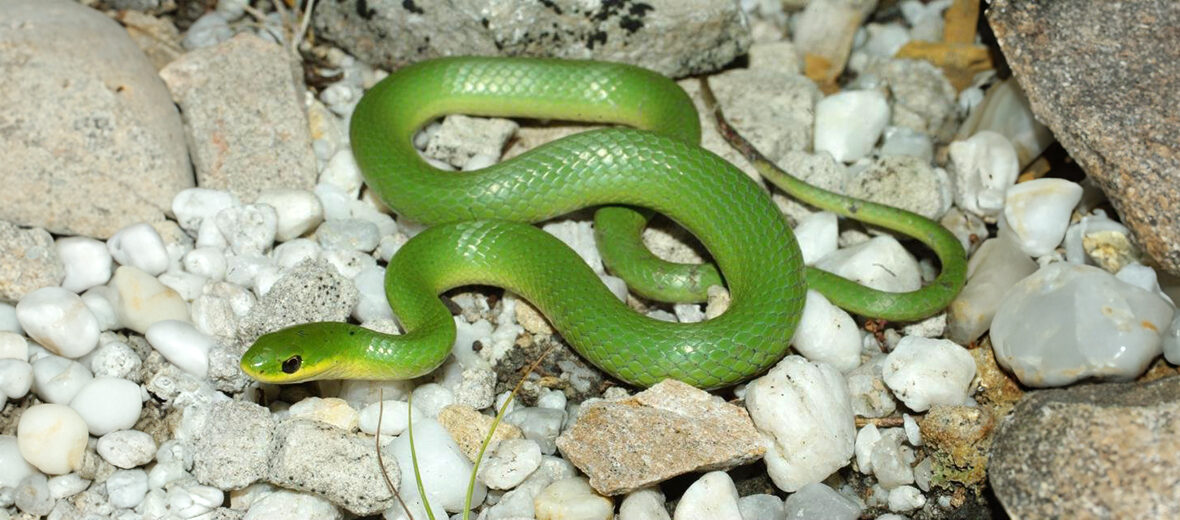
The smooth green snake, aka grass snake, is a nonvenomous colubrid. They can be found through Canada, United States, and into Mexico. They experience the threats of habitat loss and destruction at the hands of residential and commercial developments, logging, farming, and ranching; road construction, which can divide their territories and can result in vehicle strike – being hit by vehicles; climate change, which can result in temperature extremes; and recreational activities, which can degrade their habitats and cause deaths by vehicle strike. But overall, these snakes are abundant and listed as Least Concern by the IUCN. Their population trend is stable.
First the Stats…
Scientific name: Opheodrys vernalis
Weight: Up to .69 ounces
Length: Up to 20 inches
Lifespan: Up to 15+ years
Now on to the Facts!
1.) They get their common name from their smooth dorsal scales, unlike the rough green snake, which has keeled, or raised dorsal scales.
2.) These snakes prefer marshes, meadows, open woods, and around stream edges.
3.) When handled, these non-aggressive snakes seldom bite, and prefer to flee when faced with danger.
4.) There are only a few states (Colorado, Iowa, Indiana, Michigan, Missouri, Montana, Nebraska, North Carolina, Texas, and Wyoming) that protect the smooth green snake via conservation laws. The laws prohibit commercial collection of the snake and collection by individuals.
5.) Even though they can climb, they prefer the terrestrial (spend their lives on the ground) life.
But wait, there’s more on the smooth green snake!
6.) When brumating (hibernation for reptiles) these snakes look for ant hills, burrows, and other dug-out underground areas, typically gathering into large numbers.
7.) Mating takes place between spring and summer and the females will lay their up to 14 eggs from June – September.
Did you know…?
If mishandled, these snakes will release a musk (a foul smelling liquid from their cloaca – anus) that takes quite a bit of scrubbing to remove.
8.) Eggs are laid in mounds of rotting vegetation, rotting logs, rodent burrows, or sawdust piles, and nests are often communal in that other smooth green snakes will lay their eggs together.
9.) The eggs hatch in up to 23 days, and the snakelets are precocial (totally self sufficient).
10.) These, and all snakes, are deaf. They do pick up vibrations from the ground and air to figure out their surroundings.
But wait, there’s still more on the smooth green snake!
11.) When hunting, they will slither while moving their head from side to side and flicking their tongue to detect prey items.
12.) Like all snakes, they rely heavily on their Jacobson’s organ (also known as the vomeronasal organ – VNO) to detect scents. This organ is located in the roof of their mouth. Their tongue picks up scents and deposits them into the organ which relays information about their surroundings.
13.) Smooth green snakes primarily eat insects and spiders, including ants, caterpillars, harvestmen, moths, snails, worms, and slugs. During hunting, they use both chemical and visual clues to find their prey, and kill with a strike rather than via constriction, like many other colubrids usually do.
14.) Red-tailed hawks, herons, buzzards, bears, raccoons, badgers, foxes, cats, and dogs all prey on smooth green snakes.
Now a Short Smooth Green Snake Video!
Be sure to share & comment below! Also, check out the Critter Science YouTube channel. Videos added regularly!
Want to suggest a critter for me to write about? Let me know here.
Some source material acquired from: Wikipedia & IUCN
Photo credit: Amphibians and Reptiles of South Dakota




